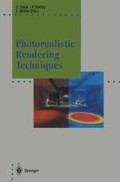Abstract
Most of the research on the global illumination problem in computer graphics has been concentrated on finite-element (radiosity) techniques. Monte Carlo methods are an intriguing alternative which are attractive for their ability to handle very general scene descriptions without the need for meshing. In this paper we study techniques for reducing the sampling noise inherent in pure Monte Carlo approaches to global illumination. Every light energy transport path from a light source to the eye can be generated in a number of different ways, according to how we partition the path into an initial portion traced from a light source, and a final portion traced from the eye. Each partitioning gives us a different unbiased estimator, but some partitionings give estimators with much lower variance than others. We give examples of this phenomenon and describe its significance. We also present work in progress on the problem of combining these multiple estimators to achieve near-optimal variance, with the goal of producing images with less noise for a given number of samples.
Access this chapter
Tax calculation will be finalised at checkout
Purchases are for personal use only
Preview
Unable to display preview. Download preview PDF.
References
J. Hammersley, D. Handscomb, Monte Carlo Methods, Chapman and Hall, 1964.
M. Kalos, P. Whitlock, Monte Carlo Methods, Volume I: Basics. J. Wiley, New York, 1986.
R. Cook, T. Porter, L. Carpenter, Distributed ray tracing. Computer Graphics (Siggraph ’84), 18, 137–146 (1984).
J. Arvo, D. Kirk, Particle transport and image synthesis, Computer Graphics (Siggraph ’90), 24, 63–66 (1990).
P. Shirley, C. Wang, Luminaire sampling in distribution ray tracing. Technical Report 343, CS Dept., Indiana University, Jan 1992. Also appears in: Siggraph ’93 Global Illumination Course Notes.
J. Kajiya, The rendering equation. Computer Graphics (Siggraph ’86), 20, 143–150 (1986).
D. Kirk, J. Arvo, Unbiased sampling techniques for image synthesis, Computer Graphics (SIGGRAPH ’91), 25, 153–156 (1991).
F. Sillion, J. Arvo, S. Westin, D. Greenberg, A global illumination solution for general reflectance distributions. Computer Graphics (SIGGRAPH ’91), 25, 187–196 (1991).
D. Baum, S. Mann, K. Smith, J. Winget, Making radiosity usable: automatic pre-processing and meshing techniques for the generation of accurate radiosity solutions. Computer Graphics (SIGGRAPH ’91), 25, 51–60 (1991).
D. Lischinski, F. Tampieri, D. Greenberg, Combining hierarchical radiosity and discontinuity meshing. Computer Graphics (SIGGRAPH ’93), 27, 199–208 (1993).
S. Pattanaik, S. Mudur, Efficient potential equation solutions for global illumination computation. Computers and Graphics, 17 (4), 387–396 (1993).
S. Chen, H. Rushmeier, G. Miller, D. Turner, A progressive multi-pass method for global illumination. Computer Graphics (SIGGRAPH ’91), 25, 165–174 (1991).
M. Watt, Light-water interaction using backward beam tracing. Computer Graphics (SIGGRAPH ’90), 24, 377–385 (1990).
P. Shirley, A ray tracing method for illumination calculation in diffuse-specular scenes. Graphics Interface ’90, 205–212 (1990).
J. Arvo, Backward ray tracing. SIGGRAPH ’86 “Developments in Ray Tracing” course notes (1986).
P. Heckbert, Adaptive radiosity textures for bidirectional ray tracing. Computer Graphics (SIGGRAPH ’90), 24, 145–154 (1990).
P. Shirley, Time complexity of Monte-Carlo radiosity. Eurographics ’91 Proceedings, 459–465 (1991).
P. Shirley, K. Sung, W. Brown, A ray tracing framework for global illumination. Graphics Interface ’91, 117–128 (1991).
B. Lesaec, C. Schlick, A progressive ray-tracing based radiosity with general reflectance functions. Eurographics Workshop on Photo simulation, Realism, and Physics in Computer Graphics, 1990.
G. Ward, F. Rubinstein, R. Clear, A ray tracing solution for diffuse interreflection. Computer Graphics (SIGGRAPH ’88), 22, 85–92 (1988).
E. Lafortune, Y. Willems, Bidirectional path tracing. Compu Graphics Proceedings (Alvor, Portugal), 145–153 (Dec. 1993).
M. Cohen, J. Wallace, Radiosity and Realistic Image Synthesis. Academic Press, 1993.
Lewins, Jeffery, Importancef The Adjoint Function: The Physical Basis of Variational and Perturbation Theory in Transport and Diffusion Problems. Pergamon Press, New York, 1965.
J. Spanier, E. Gelbard, Monte Carlo Principles and Neutron Transport Problems, Addison-Wesley, 1969.
P. Christensen, D. Salesin, T. DeRose, A continuous adjoint formulation for ra-diance transport. Fourth Eurographics Workshop on Rendering, 1993.
S. Pattanaik, S. Mudur, The Potential Equation and Importance in Illumination Computations. Computer Graphics Forum, 12 (2), 131–136 (1993).
B. Smits, J. Arvo, D. Salesin, An importance-driven radiosity algorithm. Computer Graphics (SIGGRAPH ’92), 26, 273–282 (1992).
Author information
Authors and Affiliations
Editor information
Editors and Affiliations
Rights and permissions
Copyright information
© 1995 EUROGRAPHICS The European Association for Computer Graphics
About this paper
Cite this paper
Veach, E., Guibas, L. (1995). Bidirectional Estimators for Light Transport. In: Sakas, G., Müller, S., Shirley, P. (eds) Photorealistic Rendering Techniques. Focus on Computer Graphics. Springer, Berlin, Heidelberg. https://doi.org/10.1007/978-3-642-87825-1_11
Download citation
DOI: https://doi.org/10.1007/978-3-642-87825-1_11
Publisher Name: Springer, Berlin, Heidelberg
Print ISBN: 978-3-642-87827-5
Online ISBN: 978-3-642-87825-1
eBook Packages: Springer Book Archive

